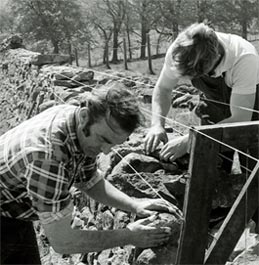| ENCLOSURES |
|
|
|
 |
Repairing a dyke, Roxburghshire |
Walls, fences or hedges were needed to separate growing crops from livestock. As stone was common almost everywhere, dykes (walls) were built in most areas, often without the use of mortar – hence 'drystone'. Specialist squads of dykers were needed to build walls which would withstand the test of time.
Here, Tom Arres and his squad are repairing a dyke near Jedburgh, in the late 1960s. The work on this section involves a complete rebuilding. Stone for building was gathered locally beforehand or quarried if necessary.
One or more wooden frames are set up with a vertical plumb line and horizontal lines of string to give a profile for the dyke. |

Resource pack
|
 |
|
|





